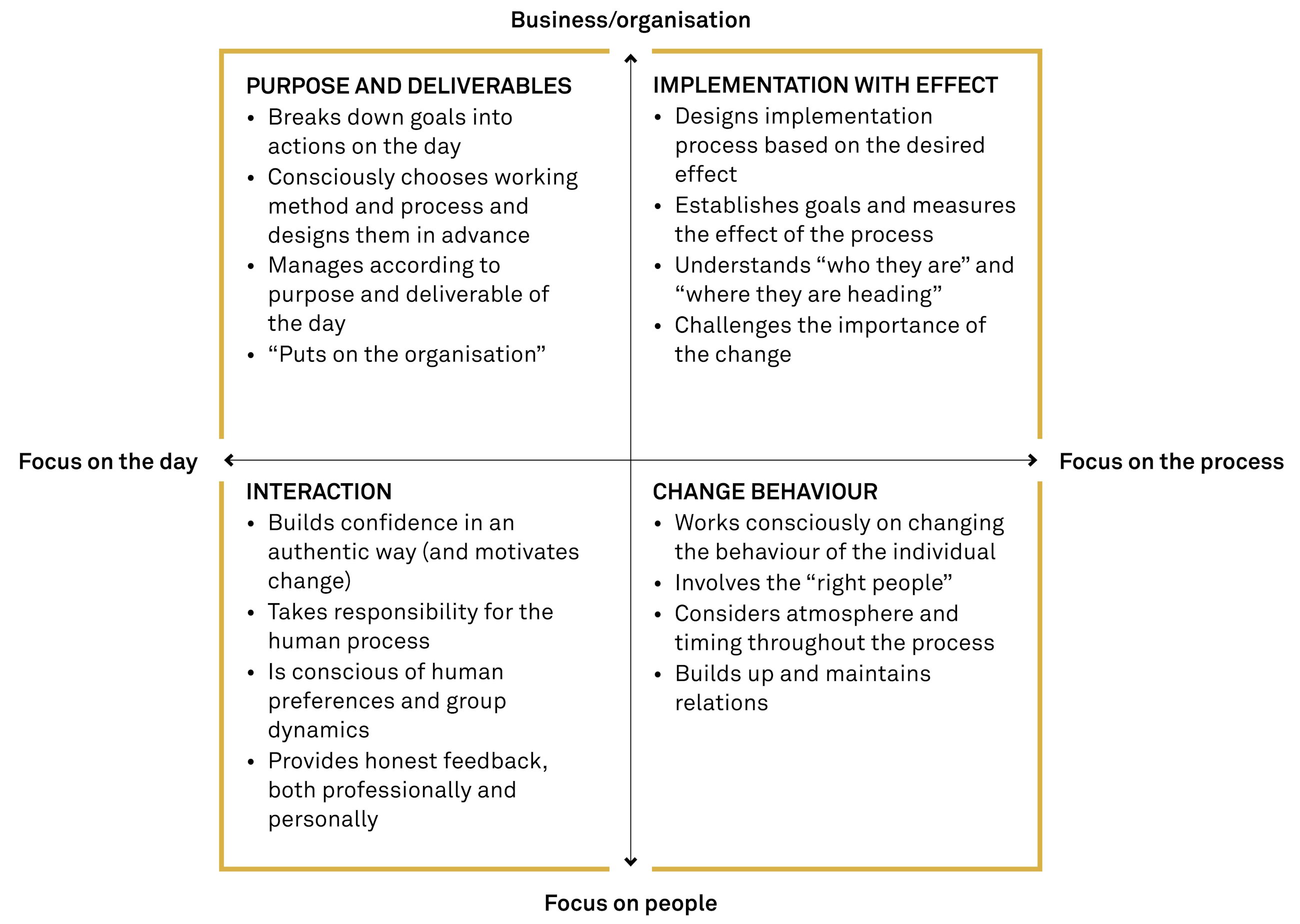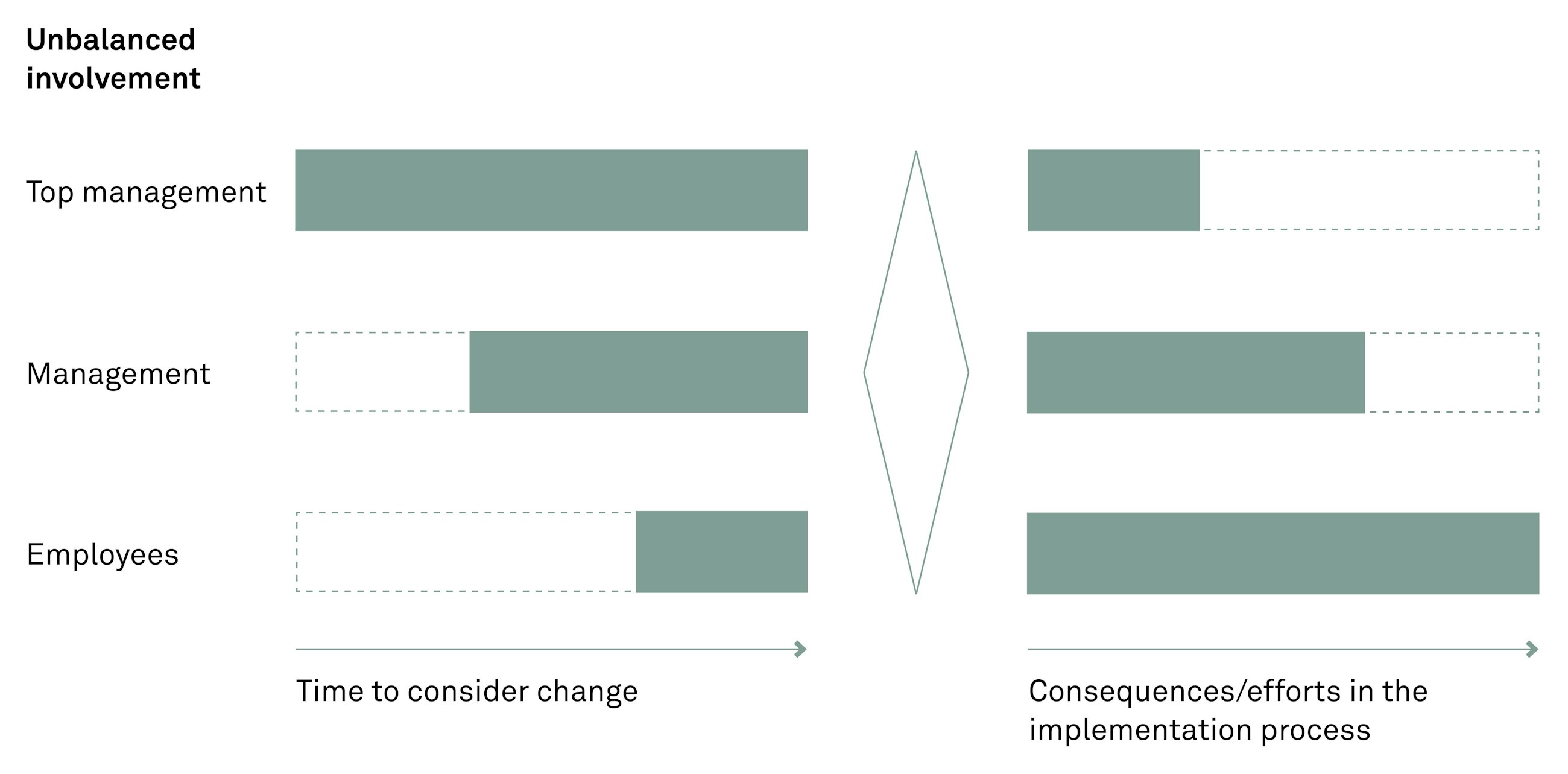From project to business value with change management
11 November 2015
The project manager is responsible for realising the deliverables – and the change manager for creating long-lasting value. These two roles must be linked more closely in future project management tasks in order to realise the benefits of the project.
Do you know of any projects where the deliverables were celebrated with a bang but the effect did not occur? Then you may have underestimated the change management task in the project.
The purpose of this article is to provide project managers, programme managers, project office employees and HR employees with inspiration for how to incorporate change management in projects at an early stage and in a structured manner.
Project manager now as change manager
The project manager needs both structural elements and change management elements in order to succeed with the project and realise the benefits of the project. Therefore, the most essential role of the project manager is to ensure actual effect and organisational change of the project. This may seem simple, however, it is in fact an overlooked dimension in many projects.
Traditionally, the project manager’s task is to ensure the deliverables and keep focus on the product. What is currently seen and advocated is for the project manager to keep focus on value to a higher degree and to select the project management team accordingly. Consequently, focus needs to shift from “what” the project is to deliver to “why” the project has been initiated.
The role as change manager
The change manager is dedicated to making change happen in the organisation. Are people doing something today which is different from yesterday? Are they talking differently about the change? In some organisations, the role as change manager is quickly reduced to “the person who is responsible for communication and education”.
The role includes these things AND much more. The change manager is the one who conceptualises the entire transformation and is responsible for changes in knowledge, attitude and behaviour. The desired effect will determine how the change manager should work. A higher degree of behavioural change means increased interaction with the organisation. The change manager must design and facilitate real changes as obligatory passage points that are conducted at an early stage of the project. For example, feedback from the employees could be an obligatory passage point in a management development project.
Another passage point could be that projects must be specified in a project description in order to get budget approval. Therefore, the change manager must have an eye for the entire project process as well as the small processes, such as facilitating a one-day event in a professional manner. The change manager must maintain focus on both the business effect and the human aspect of the process. This means that the change manager should set specific effect goals for both dimensions and design processes in the project, which lead to realisation of the effects. We often find that each organisation has a preference for either one or the other dimension. Here, the change manager has to build a bridge between e.g. HR and the finance department.
The change manager’s focus during the project
Creating real change through involvement
People need to be in focus in order for us to reap the business effects. We want to challenge the concept of “resistance to change” and focus on real and early involvement of those who need to change the most. We believe that you will get what you are looking for. Implied in the concept of resistance is the inherent assumption that we as individuals automatically want to maintain the status quo. Thus, people are perceived as retrospective and reactionary individuals and not as independently thinking, reflecting actors who have and are able to play an actively participating role.
We believe that we are overlooking great potential and resources that can assist in the transformation process when viewed through the resistance approach. By participating in organisational conversations and being part of creating the reality and the vocabulary that construct the concrete change, we can make it possible for the stakeholders to create an understanding of “why” and implement the change in their working life. In short, the change manager’s job is to communicate two central messages: 1) What is the purpose of this change? and 2) How does it affect you? These messages are to supplement the obligatory passage points in the project. A study carried out in a sales organisation among 500 employees confirms these actions. The figure shows that a person’s own will is a highly decisive factor in the implementation of a change. Add to this the attention of the management and changed working procedures (passage points).
Thus, the first step in creating importance is about whether one can relate it to one’s own life.
Traditionally, this typically happens by creating the vision of “the fantastic” (the burning desire) or the fear of what might happen, if we do not take action now (the burning platform). Seen from a more nuanced and individual perspective, it is about being able to decipher the relevance of this concrete change for the individual person.
The process of translating the change to fit one’s own life becomes meaningful through different types of involvement. By involving the stakeholders of the change, they become a co-designing part of the change, and, thus, the essential subjective opinion of each individual is created to boost the change. As a result, the change becomes OURS and not just THEIRS.
Typically, we find that the top management decides to make a change, e.g. “we will outsource all of our SAP support”. Subsequently, the VP/department manager is informed and finally the employees.
The paradox is that the employees, who know how SAP support works on a daily basis and know which processes could be initiated with advantage to ensure that the change process works, are not involved. They only get very little time to adjust to the change.
Those who need to change the most are the ones who have the least time to figure out what the change will mean to them and make sense of it. While the management (or project management) are standing on beer boxes, talking enthusiastically about the project, the employees are in their own offices with their valued colleagues in the professional environment that they appreciate.
If the management does not acknowledge this dimension in their communication, the resistance to change will become a self-fulfilling prophecy.
We propose to involve the people who are affected by the change at an early stage of the project to ensure that a subjective meaning and a sense of importance are created. This requires that the management and the project management are prepared to provide the involved employees with the opportunity to be influential in setting the direction of the project.
- Action without importance = waste of time
- Importance without action = daydream
It is not our message to involve everybody in everything all the time. However, we need to dare to have a more open and honest debate concerning where we can create involvement, how and who needs to be involved.
What does the change manager need to do
This means that:
- The change manager involves the users, stakeholders and clients (the ones who are affected the most by the change as well as others if we think throughout the value chain) early on in the process – much earlier than we think!
- The change manager sets impact goals for both the business dimension and the human dimension of the project – two dimensions that should always be present.
- The project manager focuses on more than the subject matter and the deliverables and starts caring about the behavioural change of the end users.
- The role as change manager is characterised by more dialogue and interactional work and less one-way communication – the change manager must facilitate meaningful processes, both formal and informal, that concern the purpose of the processes and what they mean to the individual person.
- The project manager needs to acquire a new vocabulary and a different mindset to talk and think about change and must not on any account believe that the project is well on its way once the structures have been followed and the templates filled in.
Change with impact requires that project managers are not afraid of making a move in the business with an incomplete project and that they trust their abilities as facilitators. This means that project managers must not reduce change management to something that is managed at the end of a project which others must take care of. Therefore, involvement is the obligatory passage point we need to get through in order to create the change experience which puts us back on the right track as an organisation.








